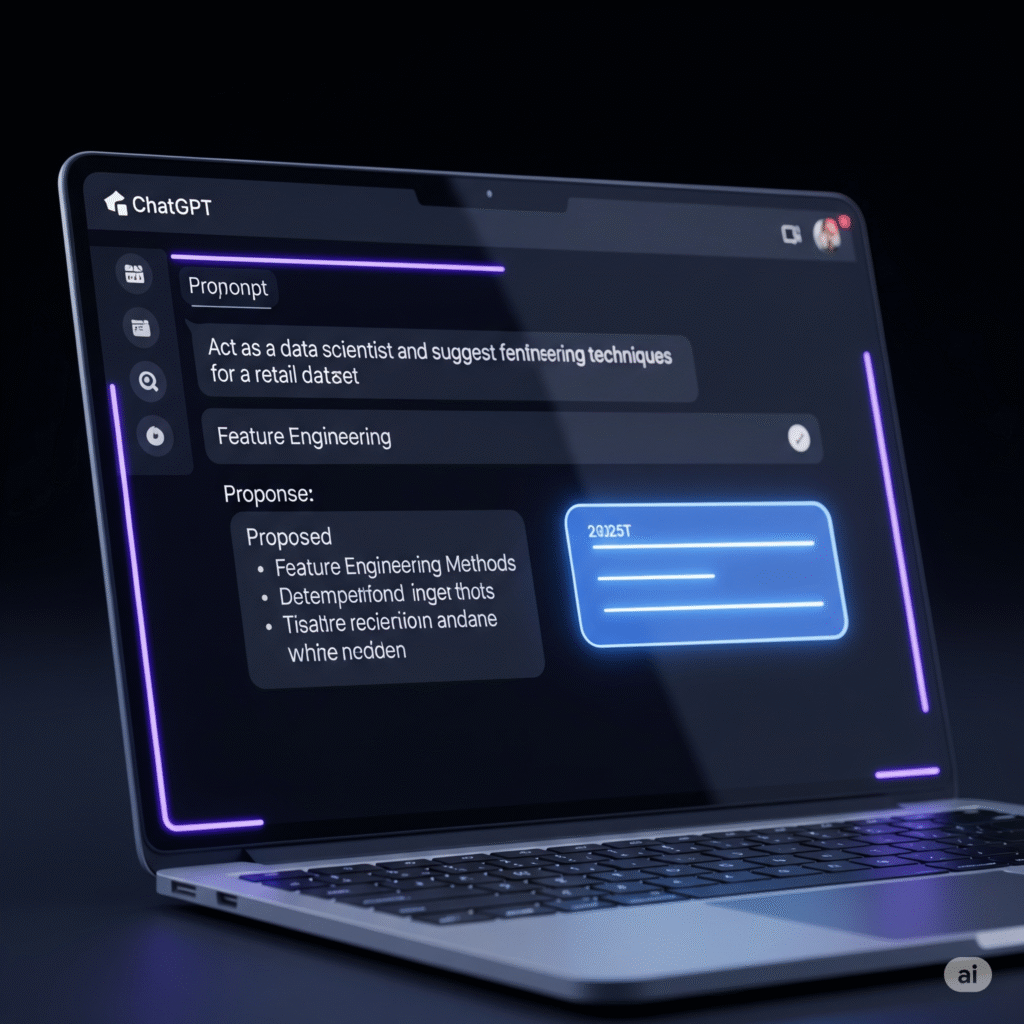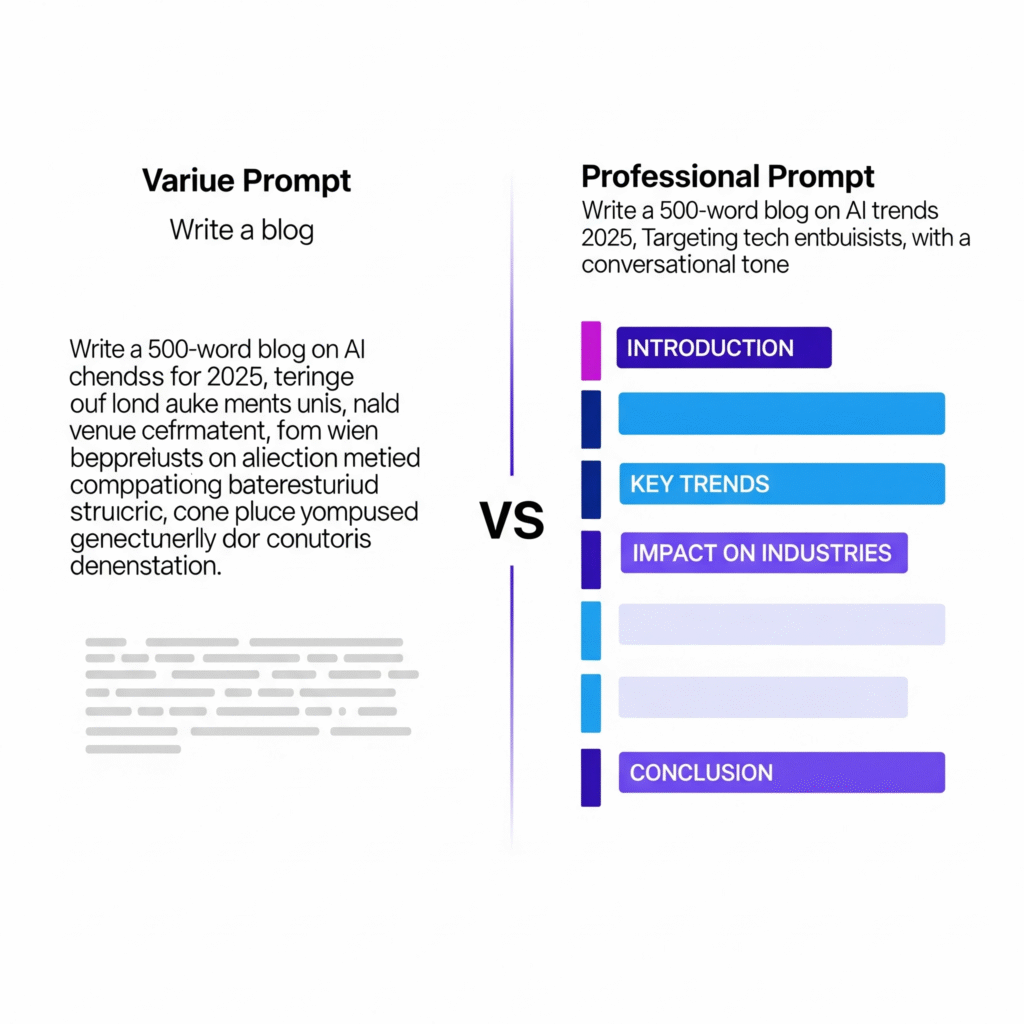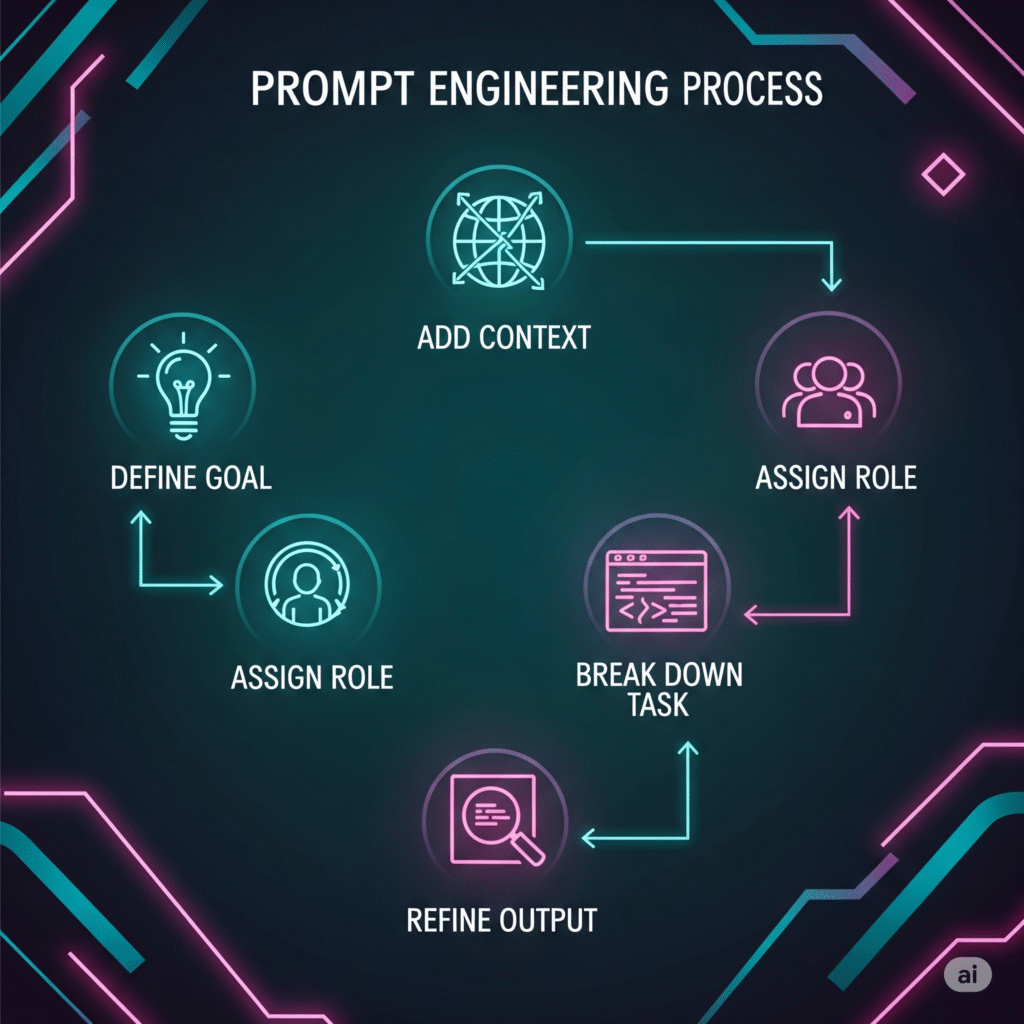Why Your ChatGPT Prompts Are Holding You Back
Ever typed a half-baked prompt into ChatGPT, like “write something cool,” and gotten a response that’s about as exciting as a user manual? We’ve all been there. Most users treat ChatGPT like a magic genie, but here’s the truth: it’s a pattern-matching beast that thrives on specificity. To unlock its full potential, you need to master prompt engineering—crafting clear, context-rich instructions that make the AI sing. Inspired by insights from the Data Science Collective (), this 2025 guide will turn you into a prompt pro with practical tips, real-world examples, and a downloadable cheat sheet to level up your AI game.

The Biggest Prompting Mistakes (And How to Fix Them)
Let’s face it: most prompts are a hot mess. Here’s how to avoid the traps and fix your approach:
- Vague Prompts: Asking “Tell me about AI” is like ordering “food” at a restaurant. Be specific: “Explain reinforcement learning with a real-world example for a beginner.”
- No Context: ChatGPT isn’t psychic. Tell it who you are: “I’m a marketing manager. Suggest a social media strategy for a tech startup.”
- Ignoring Roles: Assign a persona for better results: “Act as a Python expert and debug this code: [insert code].”
- One-Shot Overload: Don’t ask for a novel in one go. Break it down: “Outline a blog post, then write the intro.”

Pro-Level Prompting Techniques for 2025
Ready to wield ChatGPT like a pro? Here are advanced techniques to make it your ultimate productivity tool:
1. Roleplay for Precision
Give ChatGPT a role to shape its tone and expertise:
- Prompt: “Act as a cybersecurity expert and explain zero-day vulnerabilities with a step-by-step example.”
- Result: A detailed, expert-level breakdown with practical insights ().
2. Chain-of-Thought (CoT) Prompting
For complex tasks, ask ChatGPT to think step-by-step:
- Prompt: “I’m analyzing a dataset with missing values. Act as a data scientist, outline a strategy to handle them, and explain each step.”
- Result: A clear, logical plan with explanations for imputation or deletion ().
3. Lazy Prompting for Quick Wins
For simple tasks, keep it short and let ChatGPT fill in the blanks:
- Prompt: “Fix this SQL query: [insert query].”
- Result: A corrected query with minimal fuss (). Use sparingly to avoid ambiguity.
4. Decomposition for Big Projects
Break complex tasks into smaller prompts:
- Example: Instead of “Build a web app,” try:
- “Design the architecture for a blog platform using Django.”
- “Write the user authentication code.”
- “Suggest a responsive CSS layout for the homepage.”
5. Use Examples for Clarity
Show ChatGPT what you want:
- Prompt: “Write a Python function to calculate Fibonacci numbers. Here’s a sample output: [insert example].”
- Result: A tailored function matching your style ().

Real-World Applications for Data Scientists and Beyond
Prompt engineering is a superpower across industries in 2025:
- Data Science: Automate EDA or model tuning. Example: “Suggest hyperparameter tuning strategies for a random forest model on a churn dataset” ().
- Coding: Debug or optimize code. Example: “Refactor this JavaScript function for better performance: [insert code]” ().
- Content Creation: Craft blogs or reports. Example: “Write a LinkedIn post on AI trends, 200 words, professional tone.”
- Research: Summarize papers or trends. Example: “Summarize recent advances in generative AI from arXiv papers” ().
Ethical Considerations: Use AI Responsibly
ChatGPT is powerful but not perfect. It can hallucinate facts or amplify biases if mishandled (). To stay ethical:
- Verify Outputs: Double-check code or facts with trusted sources.
- Don’t Over-Rely: Use ChatGPT as a tool, not a brain replacement.
- Protect Privacy: Avoid inputting sensitive data to prevent leaks.
Pro Tips to Stay Ahead in 2025
- Maximize Context Windows: Summarize long chats to keep ChatGPT focused ().
- Try Deep Research Mode: For complex queries, use ChatGPT Pro’s Deep Research to pull from broader sources (not available in free plans) ().
- Join Communities: Check out r/ChatGPTPromptGenius or Medium’s Data Science Collective for fresh ideas (,).
- Practice Safely: Test prompts in sandboxes like Google Colab or local LLMs.
1. Assign a Persona
Tell ChatGPT exactly who it should be — an expert, a developer, a financial advisor.
- Instead of:
“Explain cybersecurity.” - Use:
“You are a seasoned penetration tester explaining common web vulnerabilities to a junior analyst.”
This steers the model into the right tone, depth, and vocabulary wsj.com.
2. Clarify Scope & Constraints
Ambiguity leads to vagueness; clarity leads to precision.
- Instead of:
“Give me marketing tips.” - Try:
“Provide three low-cost digital marketing strategies for a niche SaaS startup, with step-by-step implementation plans.”
This style—role + specifics + constraints—consistently outperforms “meh” prompts reddit.com+1tomsguide.com+1.
3. Guide the Process
Encourage structured, step-wise reasoning. Use cues like:
- “Break down step-by-step…”
- “Explain your reasoning…”
Studies show this “chain‑of‑thought” prompt style significantly boosts accuracy, especially for complex tasks medium.com+15tomsguide.com+15techradar.com+15ai.plainenglish.io+1blog.stackademic.com+1medium.com+9wsj.com+9theguardian.com+9.
4. Start Concise, Then Iterate
Concise lead prompts let the model focus; refine with follow-ups.
- Initial:
“Draft a LinkedIn bio for a data privacy expert.” - Follow-up:
“Make it more conversational and under 50 words.”
Refinement ensures clarity and avoids overloaded requests tomsguide.com+1reddit.com+1.
5. Tone & Engagement Matter
AI responds better to tone prompts — clarity, respect, even positivity.
- Example:
“Explain GDPR as if you’re speaking to a C-suite executive, in a respectful tone.”
Researchers confirm that polite, purpose-driven prompts enhance response quality tomsguide.com+5wsj.com+5tomsguide.com+5.
Putting It All Together
Example Prompt:
vbnetCopyEditYou are a cybersecurity architect advising an executive team. Outline five key steps they should take to prepare for a ransomware threat. Present each step in 2–3 bullet points, and summarize the expected impact in one sentence.
This prompt checks all boxes:
- Persona: cybersecurity architect
- Audience: executive team
- Task: outline five steps
- Format: bullet points + impact sentences
- Clarity: concise, structured, actionable
Conclusion: Prompt Like a Pro, Win Like a Pro
Prompt engineering is your ticket to unlocking ChatGPT’s full potential. By being specific, adding context, and breaking down tasks, you can make the AI work for you—whether you’re coding, analyzing data, or crafting content. In 2025, mastering this skill is non-negotiable for staying ahead in tech.
Dive deeper with resources like OpenAI’s Prompt Engineering Guide or join communities like Data Science Collective (,). Start tweaking your prompts today, and watch ChatGPT become your ultimate productivity wingman. Happy prompting!
References:
- Data Science Collective: medium.com/data-science-collective
- OpenAI Prompt Engineering Guide: openai.com